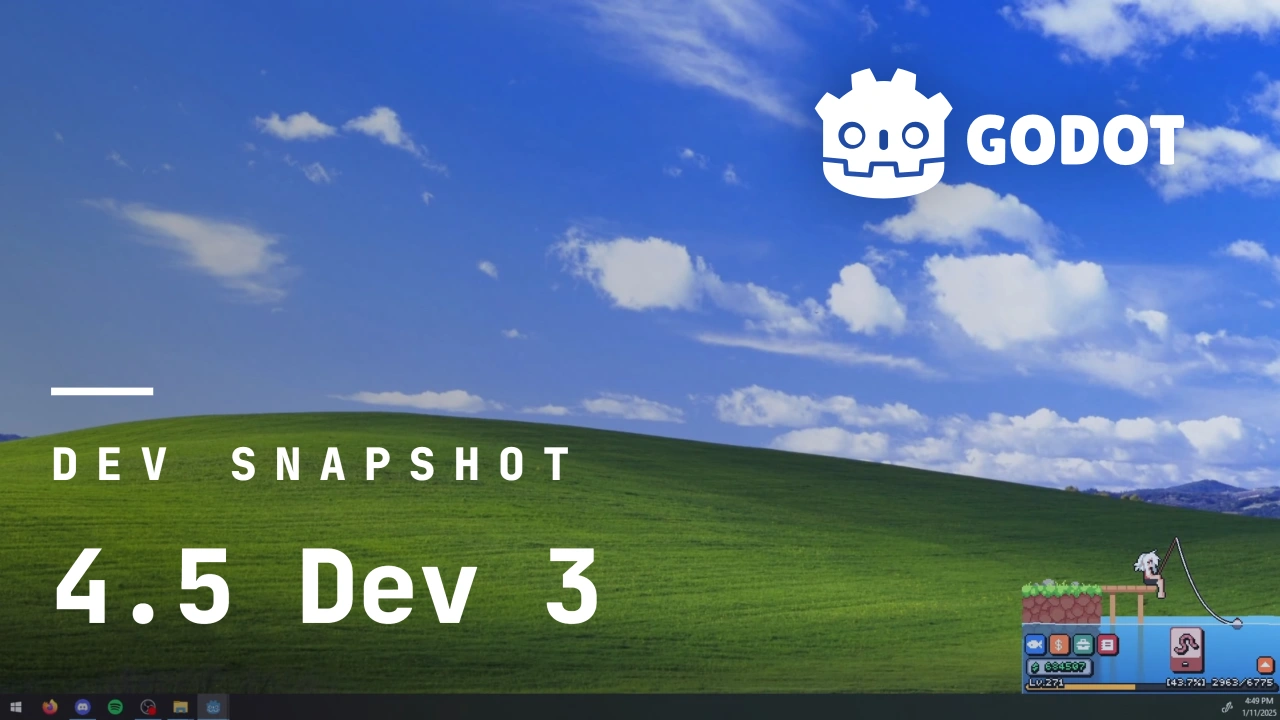
GODOTENGINE.ORG
Dev snapshot: Godot 4.5 dev 3
Cornerpond
A game by foolsroomDev snapshot: Godot 4.5 dev 3By:
Thaddeus Crews25 April 2025Pre-releaseIf the past snapshot was any indication, you might think that development updates aren’t slowing down anytime soon. And… You’d be right! Indeed, progress has been booming, and the amount of new features added even compared to the previous release is staggering; curating this selection was especially difficult. As always, new features mean new bugs in need of fixing, so we encourage everyone interested to get feedback and bug reports in as early as possible.Jump to the Downloads section, and give it a spin right now, or continue reading to learn more about improvements in this release. You can also try the Web editor or the Android editor for this release. If you are interested in the latter, please request to join our testing group to get access to pre-release builds.The cover illustration is from Cornerpond, a fishing game that takes place entirely in the corner of your desktop. It is developed by foolsroom. You can get the game on Steam and follow the developer on Twitter.HighlightsIn case you missed them, see the 4.5 dev 1 and 4.5 dev 2 release notes for an overview of some key features which were already in that snapshot, and are therefore still available for testing in dev 3.Screen reader supportAccessibility should be every developer’s top priority, full-stop. Someone being excluded from an experience for factors outside of their control is an area that video games and applications have the potential to circumvent entirely. It does, however, take a solid framework to allow such accommodations to be developed. To streamline this process for everyone—players and developers alike—our resident tech guru bruvzg took to the absolutely Herculean task of integrating AccessKit to Godot as a whole.GH-76829 was a project started two years ago, which progressed in bursts alongside the AccessKit framework. For the 4.5 release, we made it a priority to finalize, and thus we now merged this major feature with over 32,000 lines of code, after hundreds of comments with feedback/testing. Users are encouraged to look at the pull request for more information, as there’s no feasible way we could properly summarize these changes. Unsurprisingly, this was by far the change with the most ramifications of the entire snapshot, so much so that it’s already seen multiple fixes to address regressions (even one right when validating this snapshot), but it’s well worth it. After all, accessibility is our top priority!This is only the first but massive step towards making Godot more accessible. In particular for the editor, a lot more work will be needed to make it really usable, as well as integrate with accessibility frameworks for mobile or web platforms.Script backtracingIn any other snapshot, this would’ve been the main highlight, as adding backtracing to GDScript was among the most highly requested features from our users for years. Two brave souls, Mikael Hermansson (godot-jolt) and Juan Linietsky (up-and-coming developer), helmed this task and made this process possible with GH-91006. This will make it much easier for users to find the cause of warnings/errors that previously required manually hunting down bugs. Stack traces are now available in projects exported in release mode as well if the Debug > Settings > GDScript > Always Track Call Stacks project setting is enabled. This can make it easier for users to report issues in a way that developers can track down.
Inspector section togglesAnother long-awaited feature, inspector section toggles, is now a part of the engine as of GH-105272. lodetrick has expanded editor functionality to what you see below: sections with their own dedicated checkbox to denote if they’re enabled.And more!There are too many exciting changes to list them all here, but here’s a curated selection:3D: Set correct position of node with Align Transform with View in orthographic view (GH-99099).Audio: Fix AudioStreamPlayer3D stereo panning issue (GH-104853).Buildsystem: Fix .sln project generation logic for Rider to support all OS and all C++ toolchains (GH-103405).Buildsystem: Update the Android NDK to the latest LTS version (r27c) (GH-105611).C#: Avoid unnecessary StringName allocations on not implemented virtual _Get and _Set method call (GH-104689).Core: Add create_id_for_path() to ResourceUID (GH-99543).Core: Add negative index to Array.remove_at and Array.insert (GH-83027).Core: Add thread safety to Object signals (GH-105453).Editor: Autocompletion: Don’t add parenthesis if Callable is expected (GH-96375).Editor: Fix exported Node/Resource variables resetting when extending script in the SceneTreeDock (GH-105148).Editor: Project manager: Add option to backup project when it will be changed (GH-104624).Editor: Support custom features in project settings dialog (GH-105307).Export: Use project settings overrides with the target preset features instead of current platform features (GH-71542).GDExtension: Optimize gdvirtual function layout (GH-104264).GUI: Add FoldableContainer (GH-102346).GUI: Add boolean toggle for middle-click to fire tab_close_pressed signal (GH-103024).GUI: Add separate minimize_disabled and maximize_disabled window flags (GH-105107).GUI: Add support for OEM Alt codes input (GH-93466).GUI: Implement SVGTexture auto-scalable with font oversampling (GH-105375).GUI: Make embed floating window respect Always On Top configuration (GH-103731).GUI: Replace global oversampling with overrideable per-viewport oversampling (GH-104872).Input: Add configuration option to disable Scroll Deadzone on Android (GH-96139).Input: Allow all tool modes to select (GH-87756).Plugin: Add maven publishing configuration for Godot tools (GH-104819).Porting: Android: Add new actions and enhancements to TouchActionsPanel (GH-105140).Porting: Android: Embed TouchActionsPanel directly into the editor UI (GH-105518).Rendering: Detect more pipeline settings at load time to avoid pipeline stutters (GH-105175).Rendering: Renderer: Reduce scope of mutex locks to prevent common deadlocks (GH-105138).XR: OpenXR: Request the XR_KHR_loader_init extension (GH-105445).Changelog115 contributors submitted 253 fixes for this release. See our interactive changelog for the complete list of changes since the previous 4.5-dev2 snapshot.This release is built from commit 28089c40c.DownloadsGodot is downloading...Godot exists thanks to donations from people like you. Help us continue our work:Make a DonationStandard build includes support for GDScript and GDExtension..NET build (marked as mono) includes support for C#, as well as GDScript and GDExtension.While engine maintainers try their best to ensure that each preview snapshot and release candidate is stable, this is by definition a pre-release piece of software. Be sure to make frequent backups, or use a version control system such as Git, to preserve your projects in case of corruption or data loss.Known issuesThere are currently no known issues introduced by this release.With every release, we accept that there are going to be various issues, which have already been reported but haven’t been fixed yet. See the GitHub issue tracker for a complete list of known bugs.Bug reportsAs a tester, we encourage you to open bug reports if you experience issues with this release. Please check the existing issues on GitHub first, using the search function with relevant keywords, to ensure that the bug you experience is not already known.In particular, any change that would cause a regression in your projects is very important to report (e.g. if something that worked fine in previous 4.x releases, but no longer works in this snapshot).SupportGodot is a non-profit, open source game engine developed by hundreds of contributors on their free time, as well as a handful of part and full-time developers hired thanks to generous donations from the Godot community. A big thank you to everyone who has contributed their time or their financial support to the project!If you’d like to support the project financially and help us secure our future hires, you can do so using the Godot Development Fund.Donate now
0 Комментарии
0 Поделились
73 Просмотры











